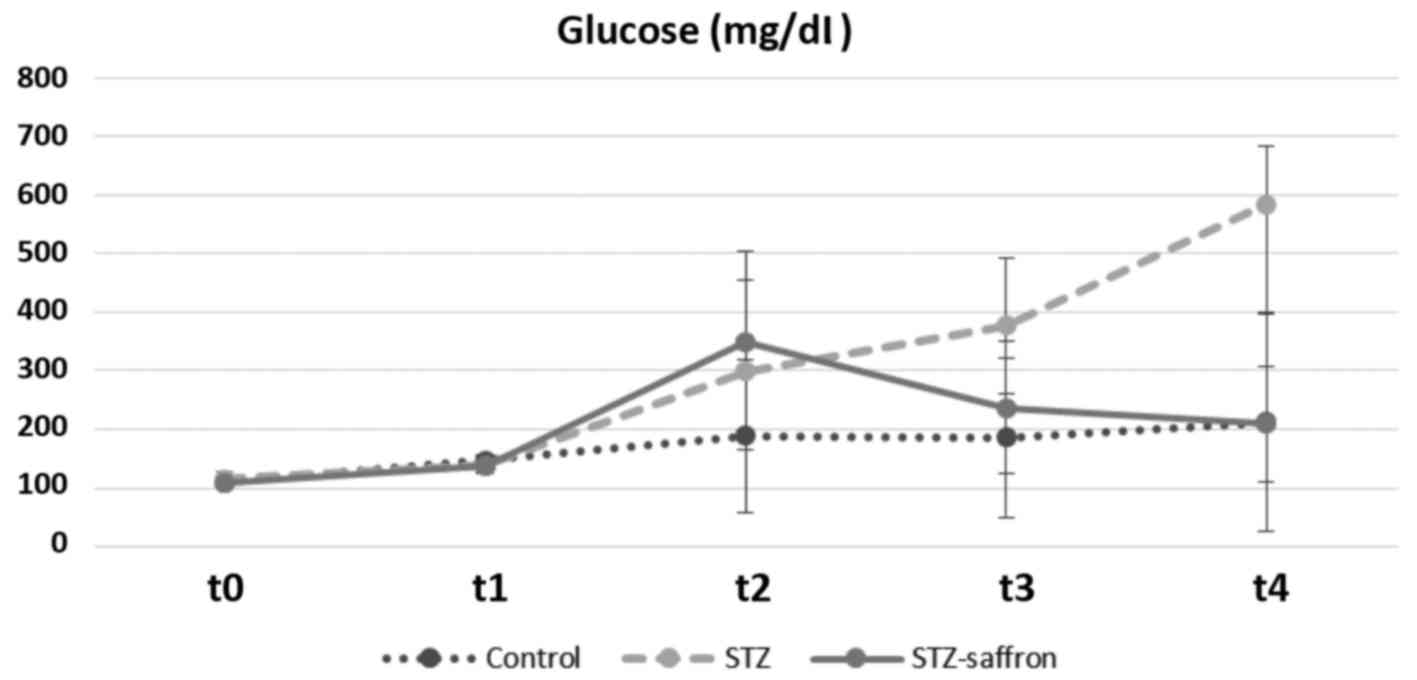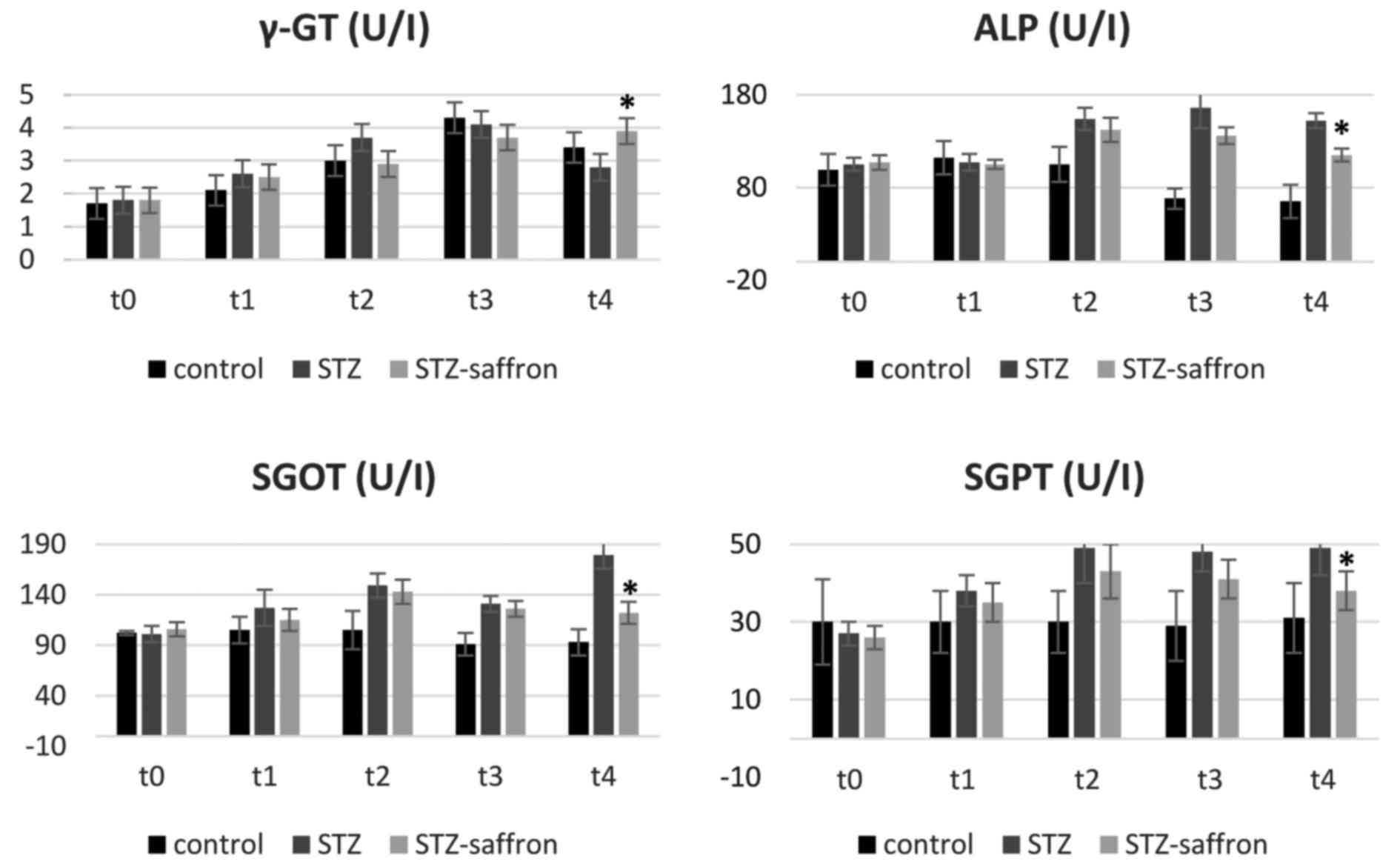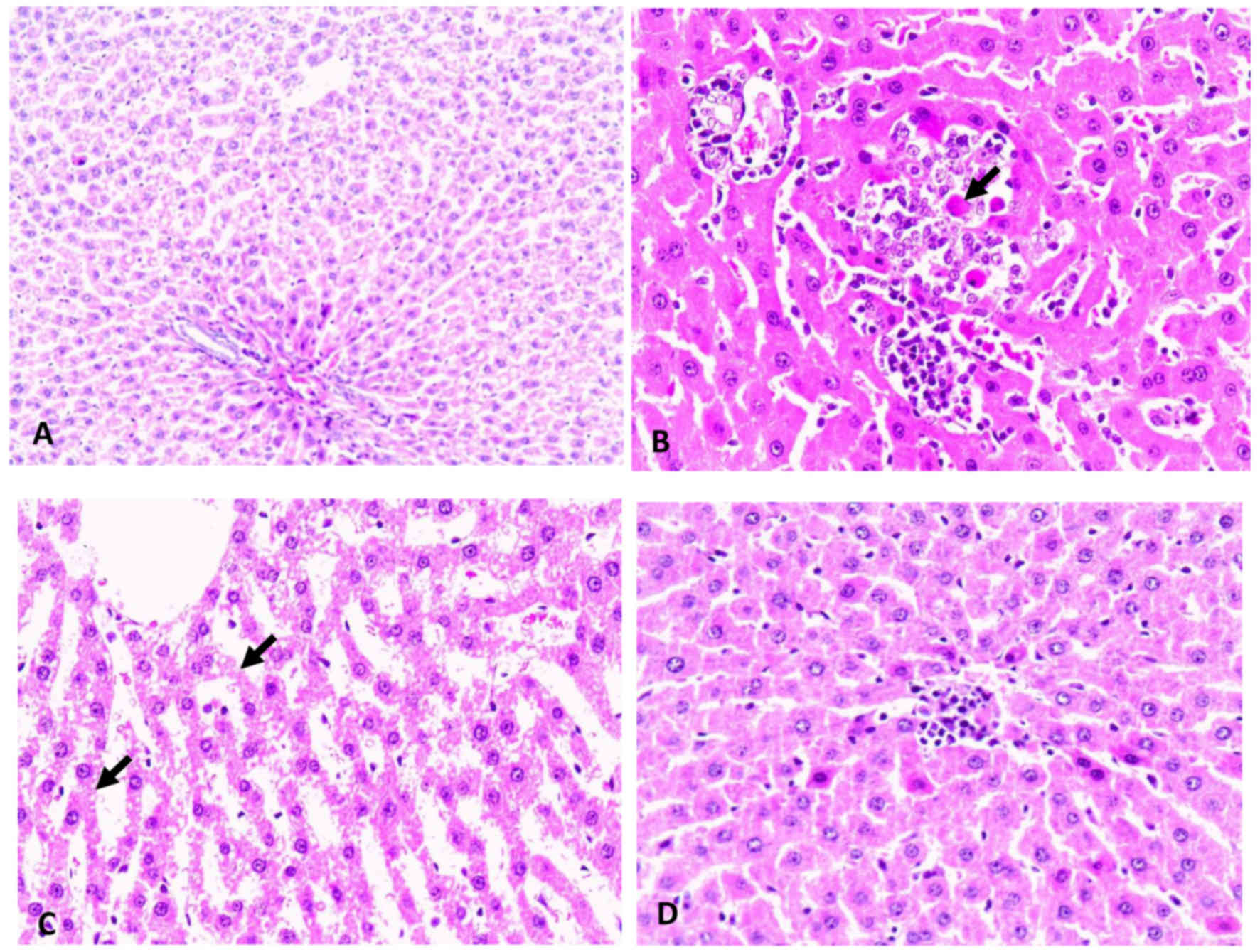|
1
|
Rathmann W and Giani G: Global prevalence
of diabetes: Estimates for the year 2000 and projections for 2030.
Diabetes Care. 27:2568–2569, author reply 2569. 2004. View Article : Google Scholar : PubMed/NCBI
|
|
2
|
Alberti KG and Zimmet PZ: Definition,
diagnosis and classification of diabetes mellitus and its
complications. Part. 1:Diagnosis and classification of diabetes
mellitus provisional report of a WHO consultation. Diabet Med 15:
539–553. 1998.
|
|
3
|
Baxter M: Treatment of type 2 diabetes: A
structured management plan. Adv Ther. 25:106–114. 2008. View Article : Google Scholar : PubMed/NCBI
|
|
4
|
Leite NC, Villela-Nogueira CA, Cardoso CR
and Salles GF: Non-alcoholic fatty liver disease and diabetes: From
physiopathological interplay to diagnosis and treatment. World J
Gastroenterol. 20:8377–8392. 2014. View Article : Google Scholar : PubMed/NCBI
|
|
5
|
Musso G, Gambino R, Cassader M and Pagano
G: Meta-analysis: Natural history of non-alcoholic fatty liver
disease (NAFLD) and diagnostic accuracy of non-invasive tests for
liver disease severity. Ann Med. 43:617–649. 2011. View Article : Google Scholar : PubMed/NCBI
|
|
6
|
Schindhelm RK, Heine RJ and Diamant M:
Prevalence of nonalcoholic fatty liver disease and its association
with cardiovascular disease among type 2 diabetic patients.
Diabetes Care. 30:e94author reply e95. 2007. View Article : Google Scholar : PubMed/NCBI
|
|
7
|
Abd El-Kader SM and El-Den Ashmawy EM:
Non-alcoholic fatty liver disease: The diagnosis and management.
World J Hepatol. 7:846–858. 2015. View Article : Google Scholar : PubMed/NCBI
|
|
8
|
Abdeen MB, Chowdhury NA, Hayden MR and
Ibdah JA: Nonalcoholic steatohepatitis and the cardiometabolic
syndrome. J Cardiometab Syndr. 1:36–40. 2006. View Article : Google Scholar : PubMed/NCBI
|
|
9
|
Bathaie SZ, Bolhasani A, Hoshyar R,
Ranjbar B, Sabouni F and Moosavi-Movahedi AA: Interaction of
saffron carotenoids as anticancer compounds with ctDNA, Oligo
(dG.dC)15, and Oligo (dA.dT)15. DNA Cell Biol. 26:533–540. 2007.
View Article : Google Scholar : PubMed/NCBI
|
|
10
|
Azimi P, Ghiasvand R, Feizi A, Hariri M
and Abbasi B: Effects of Cinnamon, Cardamom, Saffron, and Ginger
Consumption on Markers of Glycemic Control, Lipid Profile,
Oxidative Stress, and Inflammation in Type 2 Diabetes Patients. Rev
Diabet Stud. 11:258–266. 2014. View Article : Google Scholar : PubMed/NCBI
|
|
11
|
Samarghandian S, Borji A, Delkhosh MB and
Samini F: Safranal treatment improves hyperglycemia, hyperlipidemia
and oxidative stress in streptozotocin-induced diabetic rats. J
Pharm Pharm Sci. 16:352–362. 2013. View
Article : Google Scholar : PubMed/NCBI
|
|
12
|
Samarghandian S, Azimi-Nezhad M and Samini
F: Ameliorative effect of saffron aqueous extract on hyperglycemia,
hyperlipidemia, and oxidative stress on diabetic encephalopathy in
streptozotocin induced experimental diabetes mellitus. BioMed Res
Int. 2014:9208572014. View Article : Google Scholar : PubMed/NCBI
|
|
13
|
Hazman Ö and Bozkurt MF: Anti-inflammatory
and Antioxidative Activities of Safranal in the Reduction of Renal
Dysfunction and Damage that Occur in Diabetic Nephropathy.
Inflammation. 38:1537–1545. 2015. View Article : Google Scholar : PubMed/NCBI
|
|
14
|
Imajo K, Yoneda M, Kessoku T, Ogawa Y,
Maeda S, Sumida Y, Hyogo H, Eguchi Y, Wada K and Nakajima A: Rodent
models of nonalcoholic fatty liver disease/nonalcoholic
steatohepatitis. Int J Mol Sci. 14:21833–21857. 2013. View Article : Google Scholar : PubMed/NCBI
|
|
15
|
Rajaei Z, Hadjzadeh MA, Nemati H, Hosseini
M, Ahmadi M and Shafiee S: Antihyperglycemic and antioxidant
activity of crocin in streptozotocin-induced diabetic rats. J Med
Food. 16:206–210. 2013. View Article : Google Scholar : PubMed/NCBI
|
|
16
|
Bailey CJ and Day C: Traditional plant
medicines as treatments for diabetes. Diabetes Care. 12:553–564.
1989. View Article : Google Scholar : PubMed/NCBI
|
|
17
|
Hemmati M, Zohoori E, Mehrpour O, Karamian
M, Asghari S, Zarban A and Nasouti R: Anti-atherogenic potential of
jujube, saffron and barberry: Anti-diabetic and antioxidant
actions. EXCLI J. 14:908–915. 2015.PubMed/NCBI
|
|
18
|
Zafar M and Naeem-Ul-Hassan Naqvi S:
Effects of STZ-Induced diabetes on the relative weights of kidney,
liver and pancreas in albino rats: A comparative study. Int J
Morphol. 28:135–142. 2010. View Article : Google Scholar
|
|
19
|
Skovsø S: Modeling type 2 diabetes in rats
using high fat diet and streptozotocin. J Diabetes Investig.
5:349–358. 2014. View Article : Google Scholar : PubMed/NCBI
|
|
20
|
Ye JH, Chao J, Chang ML, Peng WH, Cheng
HY, Liao JW and Pao LH: Pentoxifylline ameliorates non-alcoholic
fatty liver disease in hyperglycaemic and dyslipidaemic mice by
upregulating fatty acid β-oxidation. Sci Rep. 6:331022016.
View Article : Google Scholar : PubMed/NCBI
|
|
21
|
Boskabady MH and Farkhondeh T:
Antiinflammatory, Antioxidant, and Immunomodulatory Effects of
Crocus sativus L. and its Main Constituents. Phytother Res.
30:1072–1094. 2016. View
Article : Google Scholar : PubMed/NCBI
|
|
22
|
Escribano J, Alonso GL, Coca-Prados M and
Fernandez JA: Crocin, safranal and picrocrocin from saffron (Crocus
sativus L.) inhibit the growth of human cancer cells in vitro.
Cancer Lett. 100:23–30. 1996. View Article : Google Scholar : PubMed/NCBI
|
|
23
|
Shirali S, Bathaie S Zahra and Nakhjavani
M: Effect of crocin on the insulin resistance and lipid profile of
streptozotocin-induced diabetic rats. Phytother Res. 27:1042–1047.
2013. View
Article : Google Scholar : PubMed/NCBI
|
|
24
|
Mousavi SH, Tayarani NZ and Parsaee H:
Protective effect of saffron extract and crocin on reactive oxygen
species-mediated high glucose-induced toxicity in PC12 cells. Cell
Mol Neurobiol. 30:185–191. 2010. View Article : Google Scholar : PubMed/NCBI
|
|
25
|
Xi L, Qian Z, Xu G, Zheng S, Sun S, Wen N,
Sheng L, Shi Y and Zhang Y: Beneficial impact of crocetin, a
carotenoid from saffron, on insulin sensitivity in fructose-fed
rats. J Nutr Biochem. 18:64–72. 2007. View Article : Google Scholar : PubMed/NCBI
|
|
26
|
Zhou X, Seto SW, Chang D, Kiat H,
Razmovski-Naumovski V, Chan K and Bensoussan A: Synergistic Effects
of Chinese Herbal Medicine: A Comprehensive Review of Methodology
and Current Research. Front Pharmacol. 7:2012016. View Article : Google Scholar : PubMed/NCBI
|
|
27
|
Kang C, Lee H, Jung ES, Seyedian R, Jo M,
Kim J, Kim JS and Kim E: Saffron (Crocus sativus L.) increases
glucose uptake and insulin sensitivity in muscle cells via
multipathway mechanisms. Food Chem. 135:2350–2358. 2012. View Article : Google Scholar : PubMed/NCBI
|
|
28
|
Nascimbeni F, Aron-Wisnewsky J, Pais R,
Tordjman J, Poitou C, Charlotte F, Bedossa P, Poynard T, Clément K
and Ratziu V; LIDO study Group, : Statins, antidiabetic medications
and liver histology in patients with diabetes with non-alcoholic
fatty liver disease. BMJ Open Gastroenterol. 3:e0000752016.
View Article : Google Scholar : PubMed/NCBI
|
|
29
|
Bajerska J, Mildner-Szkudlarz S, Podgórski
T and Oszmatek-Pruszyńska E: Saffron (Crocus sativus L.) powder as
an ingredient of rye bread: An anti-diabetic evaluation. J Med
Food. 16:847–856. 2013. View Article : Google Scholar : PubMed/NCBI
|
|
30
|
Asri-Rezaei S, Tamaddonfard E,
Ghasemsoltani-Momtaz B, Erfanparast A and Gholamalipour S: Effects
of crocin and zinc chloride on blood levels of zinc and metabolic
and oxidative parameters in streptozotocin-induced diabetic rats.
Avicenna J Phytomed. 5:403–412. 2015.PubMed/NCBI
|
|
31
|
Hemmati M, Asghari S, Zohoori E and
Karamian M: Hypoglycemic effects of three Iranian edible plants;
jujube, barberry and saffron: Correlation with serum adiponectin
level. Pak J Pharm Sci. 28:2095–2099. 2015.PubMed/NCBI
|













